User Manual
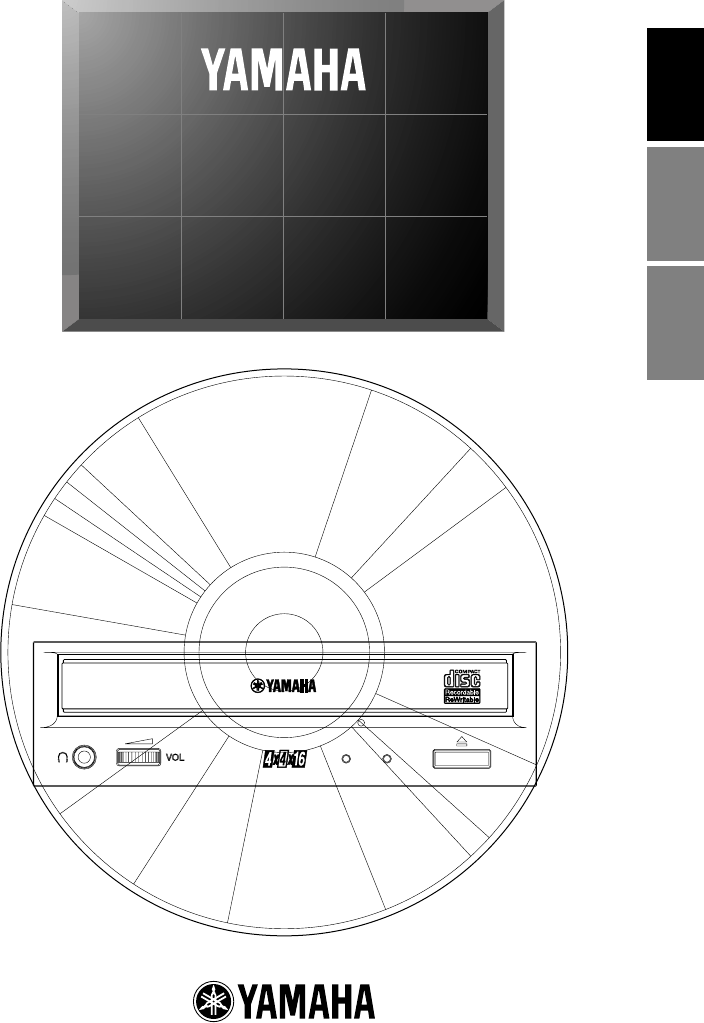
User Guide
Guide de l’utilisateur
Bedienungsanleitung
CRW4416S
SERIES
ON
/
DISC READ
/
WRITE
EnglishFrançaisDeutsch

* This manual applies to the CRW4416S and CRW4416S-NB.
The CRW4416S front panel displays the YAMAHA brand name.
The CRW4416S-NB front panel does not display a brand name.
FCC INFORMATION (U.S.A.)
1. IMPORTANT NOTICE: DO NOT MODIFY THIS UNIT!
This product, when installed as indicated in the instructions contained in this manual, meets FCC requirements. Modifications not
expressly approved by Yamaha may void your authority, granted by the FCC, to use the product.
2. IMPORTANT: When connecting this product to accessories and/or another product use only high quality shielded cables. Cable/s
supplied with this product MUST be used. Follow all installation instructions. Failure to follow instructions could void your FCC
authorization to use this product in the USA.
3. NOTE: This product has been tested and found to comply with the requirements listed in FCC Regulations, Part 15 for Class ìBî
digital devices. Compliance with these requirements provides a reasonable level of assurance that your use of this product in a
residential environment will not result in harmful interference with other electronic devices. This equipment generates/uses radio
frequencies and, if not installed and used according to the instructions found in the users manual, may cause interference harmful to
the operation of other electronic devices. Compliance with FCC regulations does not guarantee that interference will not occur in
all installations. If this product is found to be the source of interference, which can be determined by turning the product ì OFFî
and ì ONî , please try to eliminate the problem by using one of the following measures:
Relocate either this product or the device that is being affected by the interference.
Utilize power outlets that are on different branch (circuit breaker or fuse) circuits or install AC line filter/s.
In the case of radio or TV interference, relocate/reorient the antenna. If the antenna lead-in is 300 ohm ribbon lead, change the
lead-in to coaxial type cable.
If these corrective measures do not produce satisfactory results, please contact the local retailer authorized to distribute this type of
product. If you can not locate the appropriate retailer, please contact Yamaha Systems Technology, Inc. 100 Century Center Court,
San Jose, CA95112, U.S.A.
Responsible Party: Yamaha Systems Technology, Inc.
Address: 100 Century Center Court
San Jose, California 95112
Telephone: (408) 467-2330
FAX: (408) 437-8791
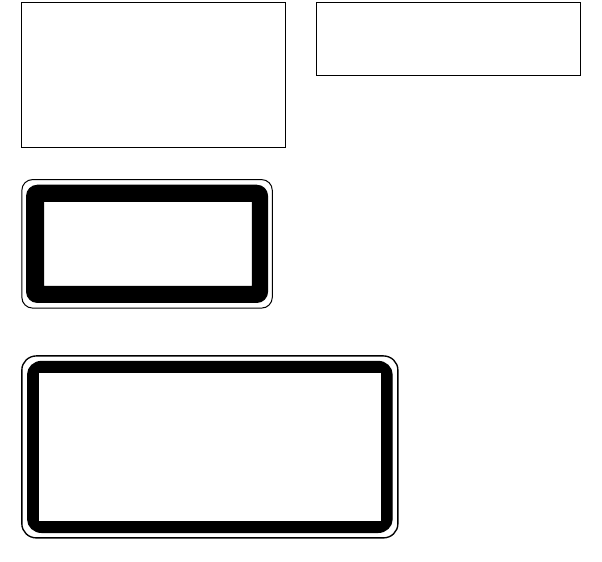
This output is value measured at a
distance 200mm from the objective lens
surface on the optical pick-up block.
ANSI Class : Class 1
Material : GaAlAs
Wavelength : 783-789 nm
Emission Duration : Continuous
Laser Output Power : Less than 44.6 µW*
*
Laser Diode Properties
CLASS 1 LASER PRODUCT
LASER KLASSE 1 PRODUKT
This compact disc player is
classified as a CLASS 1
LASER product.
The CLASS 1 LASER
PRODUCT label must be
located on the exterior.
Varningsanvisning för
laserstrålning.
VORSICHT : UNSICHTBARE LASERSTRAHLUNG WENN ABDECKUNG
GEOFFNET. NICHT DEM STRAHL AUSSETZEN.
VARNING : OSYNLIG LASERSTRÅLNING NÄR DENNA DEL ÄR ÖPPNAD OCH
SPÄRREN ÄR URKOPPLAD. BETRAKTA EJ STRÅLEN ÄR FARLIG.
VARO! : AVATAESSA JA SUOJALUKITUS OHITETTAESSA OLET
ALTTINA NÄKYMÄTTÖMÄLLE LASERS TEILYLLE. ÄLÄ KATSO SÄTESSEN.
ADVARSEL : USYNLIG LASERSTRALNING VED ÅBNING NÄR SIKKERHETSAF-
BYDERE ER UDE AF FUNKTION. UNDGÅ UDSETTELS FOR STRÅLING.
CAUTION
Use of controls or adjustments or performance of
procedures other than those specified herein may
result in hazardous radiation exposure.

WARNING
i
WARNING
❢
WARNING
❢
• The temperature where CRW4416S is located
should be between 5ºC and 40ºC (41ºF – 104ºF),
when used in a fan-cooled system.
• Do not disassemble the CRW4416S cover to
reduce the risk of electric shock.
• Always remove the disc before transporting
CRW4416S.

Important Precautions
ii
Important Precautions
Please read the following precautions before attempting
to operate the CRW4416S.
• Before recording a disc, be sure to clean the disc and
tray using an air aerosol-type dust remover.
A dust particle on the disc may cause recording to
fail, producing an unusable disc.
• Always record in a dust-free environment. If the disc
must be removed from the CRW4416S before
recording is finished, store the disc in a clean, dust-
free environment.
• The CRW4416S contains no user serviceable parts.
Refer all servicing to qualified personnel.
• If any of the following should occur, the CRW4416S
should be serviced by qualified personnel:
Metal objects or liquids get inside the CRW4416S.
The CRW4416S does not operate normally or a
marked change in performance is noticed.
• Do not place heavy objects on the CD-RW discs.
• Do not subject the CRW4416S and computer to
impact or shock when in use, as this may impair
recording or playback.
• Yamaha is not responsible for any data or informa-
tion losses resulting from the operation of the
CRW4416S.

Table of Contents
iii
Table of Contents
Introduction
...............................................................................1
CRW4416S Features .......................................................1
Orange Book Compatible Recording ..............................2
Chapter 1 -
System Configuration
......................................3
Computer .........................................................................3
Software ...........................................................................3
Tools ................................................................................4
Discs ................................................................................4
Chapter 2 - Installing the Yamaha CRW4416S Drive
........... 5
CRW4416S drive settings ...............................................5
Installing the CRW4416S drive .......................................8
Chapter 3 - Operation
............................................................13
Front Panel .....................................................................13
Loading a Disc ...............................................................14
Ejecting the Disc ............................................................15
Manual Eject (emergency use) ......................................16
Troubleshooting
.....................................................................17
Appendix
...................................................................................18
Specifications .................................................................18
Front Panel Indicator Key ..............................................19
©1998
Yama
h
a
C
orporat
i
on.
All
R
i
g
h
ts Reserve
d
.
This document may not, in whole or in part, be copied, photocopied, reproduced,
translated, transmitted or reduced to any electronic medium of machine readable
form without prior consent in writing from Yamaha.
MS-DOS and Windows are registered trademarks of Microsoft, Inc.
Unix is a registered trademark of UNIX System Laboratories.
All other trademarks are the property of their respective companies.

Introduction
1
Introduction
Thank you for purchasing a Yamaha CRW4416S drive.
Please read this manual before using the drive in order to make the best
use of the superior CRW4416S functions.
After reading, please retain this manual for future reference.
CRW4416S Features
■
4xS Recording (Rewritable) - 4xS Recording (Recordable) -
16xS Reading
The CRW4416S is able to write (overwrite) CD-RW discs at quad
speed, double speed, and is able to write CD-R discs at quad speed,
double speed, or normal speed.
For both types of media, this drive is able to read at up to 16X speed.
■
Compatible with Seven Different Formats
The CRW4416S can both record and read seven different formats: CD-
ROM, CD-ROM XA, CD-I, CD-DA, CD-Bridge (multisession), CD-
Extra, and Video CD.
The CRW4416S is also equipped with an analog audio output terminal
(headphones) for CD-DA.
■
SCSI 2 Interface for Data Transfer
The CRW4416S features SCSI 2, the second generation SCSI interface
for connecting computers and peripheral devices.
■
Compatible with Windows 95 Plug and Play
SCSI IDs are set automatically by the SCAM protocol (level 1).
■
Orange Book Part 2, Part 3 Compatible 5-Mode Recording
The CRW4416S conforms to the five recording modes outlined in the
Orange Book Part 2 and 3: Track at Once, Multisession, Disc at Once,
Session at Once, and Packet Writing.

Introduction
2
Orange Book Compatible Recording
Track at Once
In this mode, data can be recorded to disc one track at a time.
Discs recorded in this mode cannot be played in CD players or CD-
ROM drives other than a CD-RW or a CD-R drive until the session is
closed.
Multisession
In this mode, data can be recorded to disc in stages (one session at a
time).
Additional data can be written later.
Disc at Once
In this mode, data can be recorded to an entire disc in one pass.
It is not possible to write additional data later.
Session at Once
In this mode, data can be recorded to disc one session at a time.
To use this mode, your software must support Session at Once recording.
New sessions can be written later.
Packet Writing
This is useful for data back-up. Smaller units of data can be added to
tracks.
To use this mode, your software must support Packet Writing.
The CRW4416S supports both sequential and random packet writing.

Chapter 1 - System Configuration
3
Chapter 1 - System Configuration
Before using the CRW4416S, make sure that you have all of the items
on the list of included items.
In order to use the CRW4416S, you will require the following.
Computer
The following operating environment is required:
• An IBM/AT compatible computer with a 100 MHz or faster Pentium
CPU (in order to write at 4x speed), or a 100 MHz or faster 486 CPU
(in order to write at 2x speed)
• A vacant slot in which to install a SCSI card or a pre-installed SCSI
card
• A vacant half-height bay
• Windows 95, Windows NT4.0 or Higher
• Sufficient hard disk space
Note:
You will need about twice as much space on your hard disk as that
required by the data you wish to write to CD-ROM.
SCSI card
This is required in order to connect a SCSI device (the Yamaha
CRW4416S) to your computer.
We recommend the following:
Adaptec SCSI cards: AHA-2940 (PCI), AHA-284x (VL), AHA-2740
(EISA), AHA-154x (ISA), etc.
Software
Use writing software or packet writing software which supports the
CRW4416S.
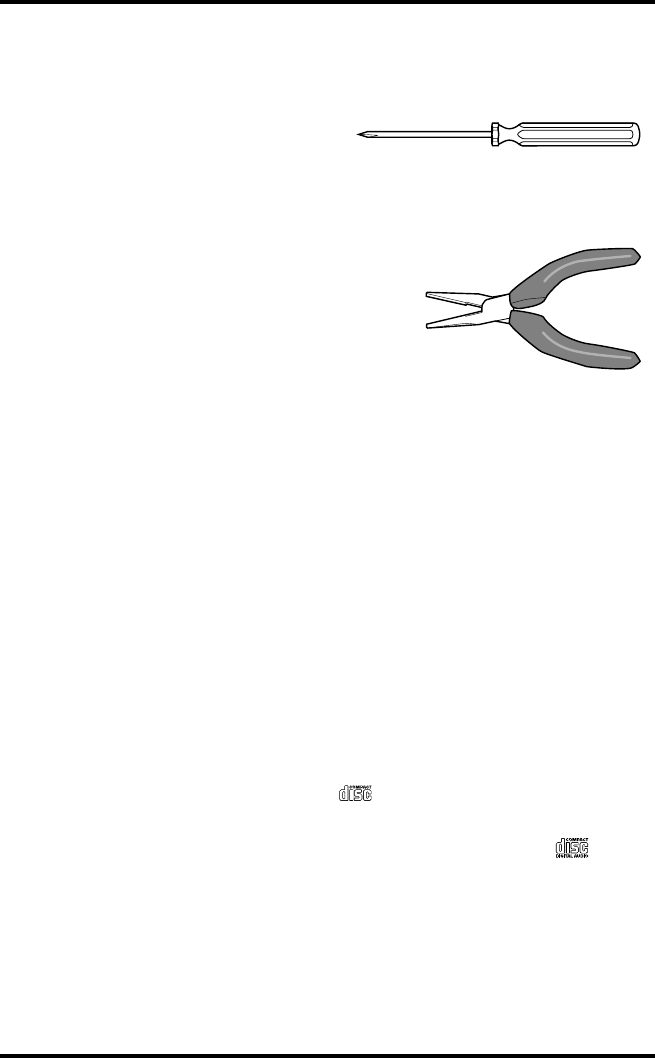
Chapter 1 - System Configuration
4
Tools
Phillips screwdriver
This is used to remove the
cover of your computer,
and to install the Yamaha CRW4416S drive.
Long nose pliers
These are used to insert or remove
the jumper pin when setting the
SCSI ID and parity settings etc.of
the Yamaha CRW4416S drive.
Discs
On the CRW4416S, you can use conventional CD-RW and CD-R discs
that conform to the Recordable Compact Disc Systems Part 2 and 3
(Orange Book).
Yamaha recommends the following Yamaha CD-RW and CD-R discs:
CD-RW Discs
> CRWM74R (
φ
120mm, 74 minutes)
CD-R Discs
> CDM12Y74M (
φ
120mm, 74 minutes)
> CDM12Y74T (
φ
120mm, 74 minutes)
Read-only Discs
You can use discs with the logo which conform to the Compact
Disc Read Only Memory standard (CD-ROM standard, Yellow Book).
If you wish to use the audio functions, use discs with the logo,
which conform to the Compact Disc Digital Audio standard (Red Book).
Phillips Screwdriver
Long nose pliers
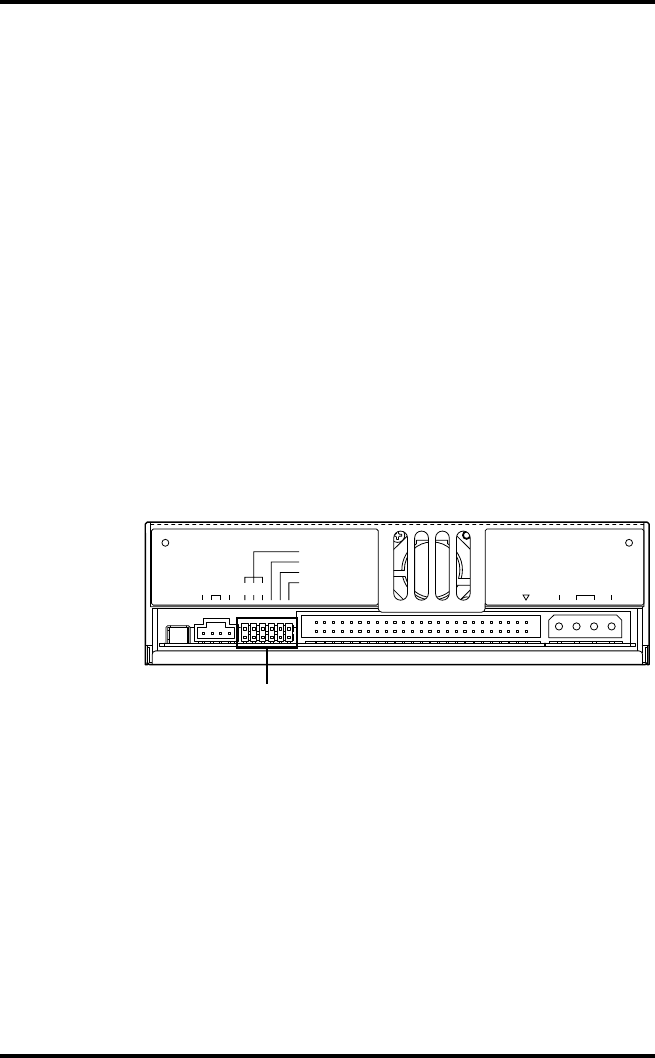
Chapter 2 - Installing the Yamaha CRW4416S Drive
5
Chapter 2 - Installing the Yamaha CRW4416S Drive
CRW4416S drive settings
Before installing the CRW4416S in your computer, you will need to set
the following jumpers.
• SCSI ID settings
• Parity setting
• Terminator setting
• Block size setting
This setting is set by inserting a jumper pin in the jumper switch
located on the rear panel of the CRW4416S drive.
Important:
Use long-nose pliers to remove or insert jumper connectors.
In the diagrams in this manual, solid black fill is used to indicate loca-
tions where a jumper is used to short between pins.
Rear Panel
■
SCSI ID settings
The SCSI ID number is used so that the computer will recognize a con-
nected SCSI device. You can assign 0 through 7 as the SCSI ID number.
Usually, “7” is reserved for the SCSI card ID number, and “0” is
reserved for the first SCSI device in the chain.
Use a number between 1 and 6 for the CRW4416S. Refer to the diagram
below for more information on setting the SCSI ID number. The factory
set ID number is “3”.
Important: If you are using other SCSI devices, be sure to use a unique ID number
for each device.
AUDIO OUT
RGL
ID SELECT
PARITY
TERMINATOR
BLOCK SIZE
1 2 4
1G
SCSI
INTERFACE
CONNECTOR DC INPUT
5V
+12V
+
Jumper Switch
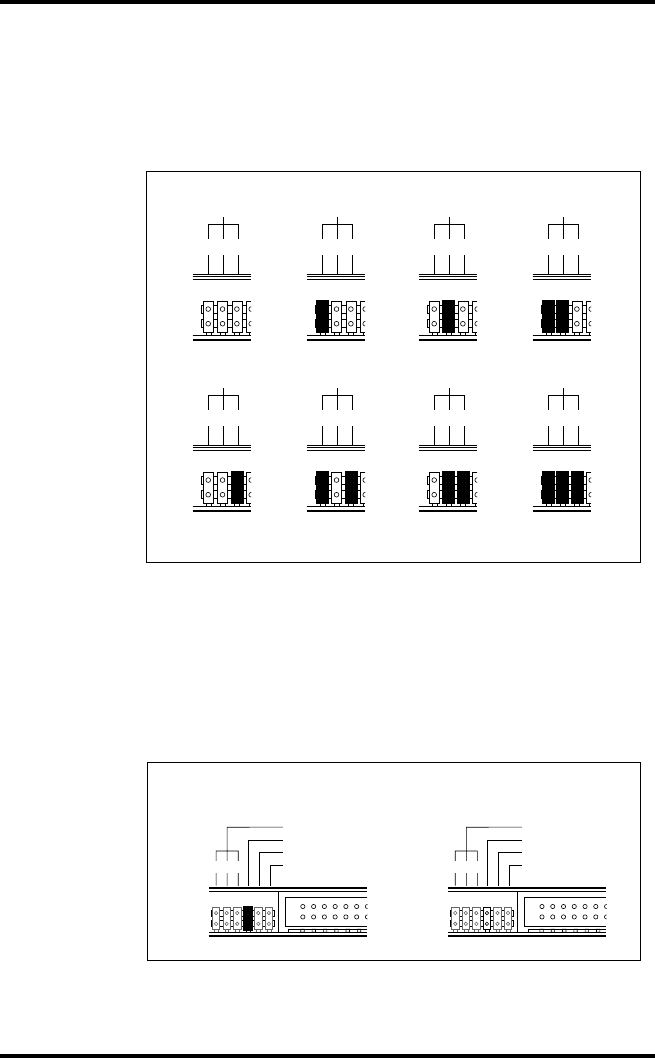
Chapter 2 - Installing the Yamaha CRW4416S Drive
6
Note:
When you are using Windows 95, and if the SCSI ID setting on the rear
panel is the same as the number assigned to another SCSI device, the
Plug and Play component of Windows 95 will automatically assign an
unused number to the CRW4416S (SCAM protocol level 1).
■
Parity setting
Parity ON
(with a jumper)
— Parity Check will be performed.
Normally, use this setting.
Parity OFF
(without a jumper)
— Parity Check will not be performed.
124
SCSI ID 1
124
SCSI ID 2
124
SCSI ID 3
124
SCSI ID 4
124
SCSI ID 5
124
SCSI ID 6
124
SCSI ID 7
124
SCSI ID 0
SCSI ID Setting
* Use jumper connectors to short the locations shown in black.
124
ID SELECT
PARITY
TERMINATOR
BLOCK SIZE 124
ID SELECT
PARITY
TERMINATOR
BLOCK SIZE
Parity ON (default) Parity OFF
* Use jumper connectors to short the locations shown in black.
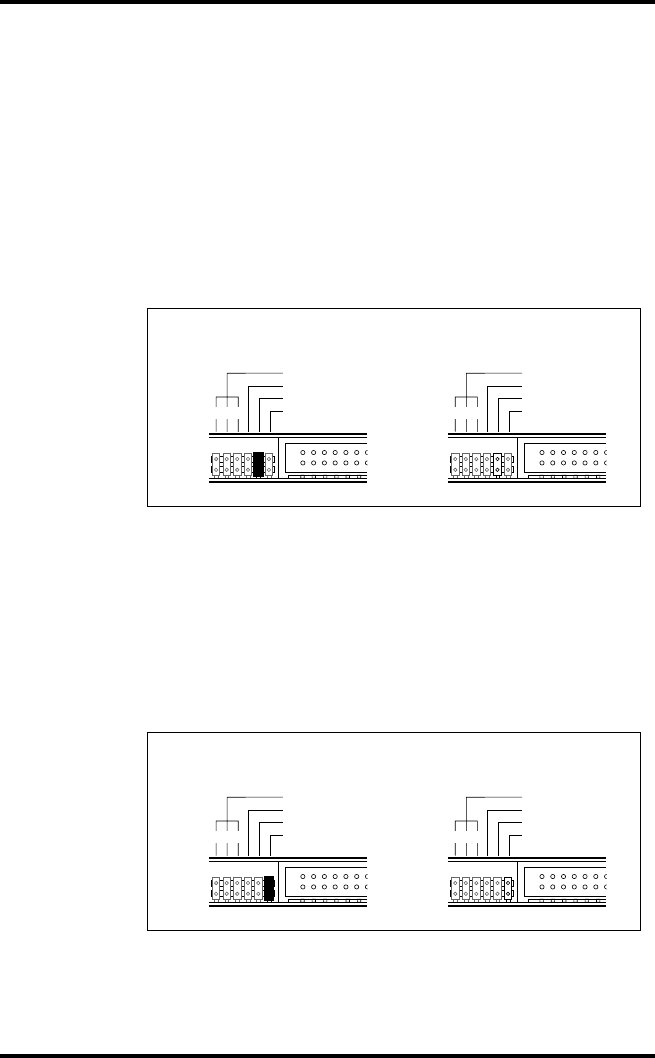
Chapter 2 - Installing the Yamaha CRW4416S Drive
7
■
Terminator setting
The terminator setting indicates whether or not this device is the last
connected SCSI device.
Terminator ON
(with a jumper)
— Use this setting if the CRW4416S is the last device in the internal
SCSI daisy-chain.
Terminator OFF
(without a jumper)
— Use this setting if devices other than the CRW4416S are in the
internal SCSI daisy-chain and the CRW4416S is not the last device.
■
Block size setting
Block size ON
(with a jumper)
— Block Size is set to 512Byte/sector. This function is valid only for
workstations, such as those that run UNIX.
Block size OFF
(without a jumper)
—
Normally, use this setting.
124
ID SELECT
PARITY
TERMINATOR
BLOCK SIZE 124
ID SELECT
PARITY
TERMINATOR
BLOCK SIZE
Terminator ON (default) Terminator OFF
* Use jumper connectors to short the locations shown in black.
124
ID SELECT
PARITY
TERMINATOR
BLOCK SIZE 124
ID SELECT
PARITY
TERMINATOR
BLOCK SIZE
Block size ON Block size OFF (default)
* Use jumper connectors to short the locations shown in black.
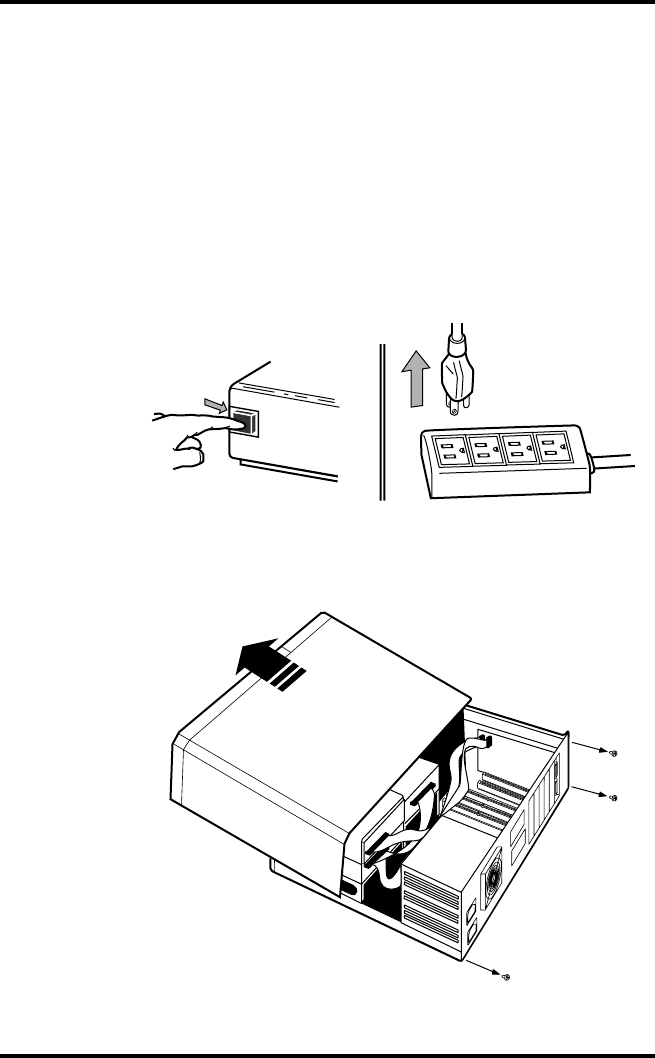
Chapter 2 - Installing the Yamaha CRW4416S Drive
8
Installing the CRW4416S drive
The following steps will differ slightly depending on the type of com-
puter you are using.
For details on removing the cover from your computer, and installing or
removing internal devices, refer to the manual for your computer.
1. Switch off your computer, and unplug it from the AC outlet.
If you fail to do this, there is a danger of electric shock and/or of causing
short circuits, which may damage the computer and/or CRW4416S drive.
2. Remove the cover from your computer.
Be careful not to lose the screws that were removed.
PUSH
OFF
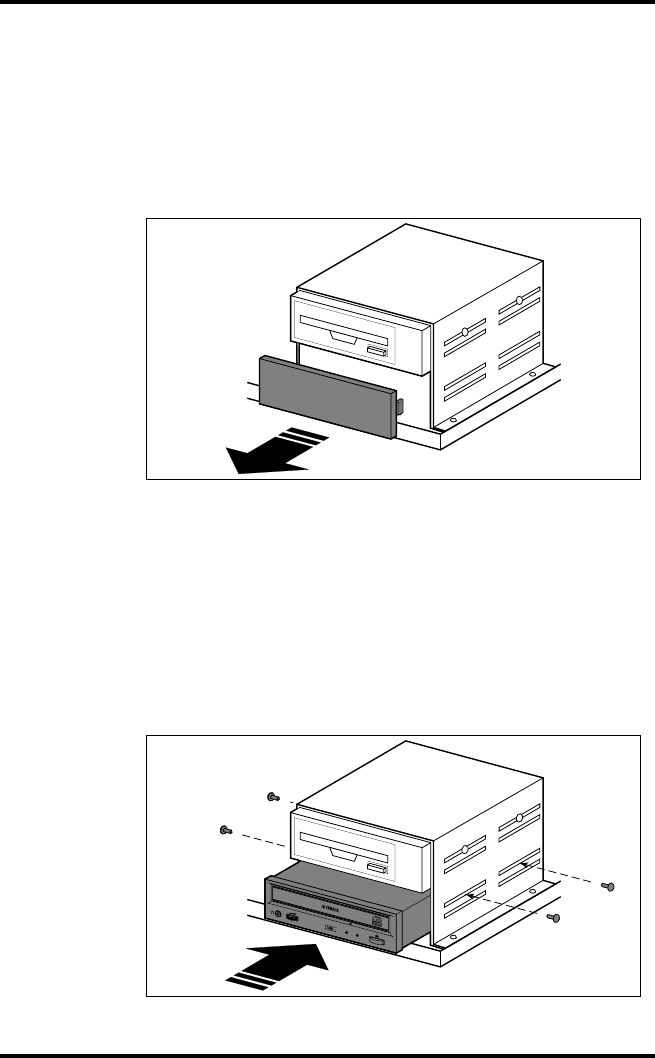
Chapter 2 - Installing the Yamaha CRW4416S Drive
9
3. Your hands or body may be holding a charge of static elec-
tricity. Touch a metallic portion of the chassis or power sup-
ply to release any such charge.
4. Remove the front cover of a vacant half-height drive bay.
For details refer to the manual of your computer.
5. Remove the SCSI card, and set the terminator setting of the
SCSI internal circuit to the position for internal connected
devices. For details refer to the manual of your SCSI card.
6. Slide the CRW4416S drive into the drive bay from the front.
At this time, be careful not to apply excessive force to the drive itself.
Finger-tighten the four fastening screws, and check that there is enough
room to connect the power supply cable, SCSI cable, and AUDIO cables.
ON
/
DISCREAD
/
WRITE
VOL
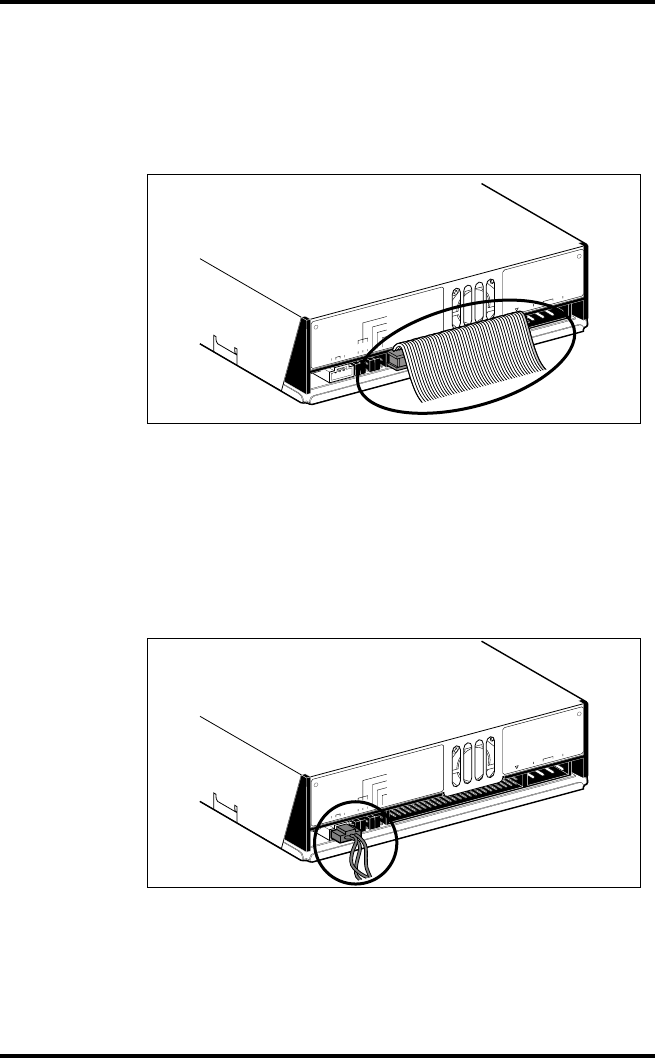
Chapter 2 - Installing the Yamaha CRW4416S Drive
10
7. Connect the SCSI flat cable.
Connect the 50-pin SCSI flat cable to the SCSI card and to the SCSI
interface located on the rear panel of the CRW4416S drive.
Position the connector so that the colored line is at pin 1 (your lower right).
8. Connect the AUDIO cable.
Connect the single 4-pin connector (Sound Blaster compatible) to the
sound card.
Connect the 4-pin connector at the other end of the cable (the larger
connector) to the AUDIO OUT connector on the CRW4416S drive.
The polarizing lug should be at the top.
R G L 1 2 4
ID SELECT
PARITY
TERMINATOR
BLOCK SIZE
AUDIO OUT
1 +5V G +12V
SCSI
INTERFACE
CONNECTOR DC INPUT
R G L 1 2 4
ID SELECT
PARITY
TERMINATOR
BLOCK SIZE
AUDIO OUT
1 +5V G +12V
SCSI
INTERFACE
CONNECTOR DC INPUT
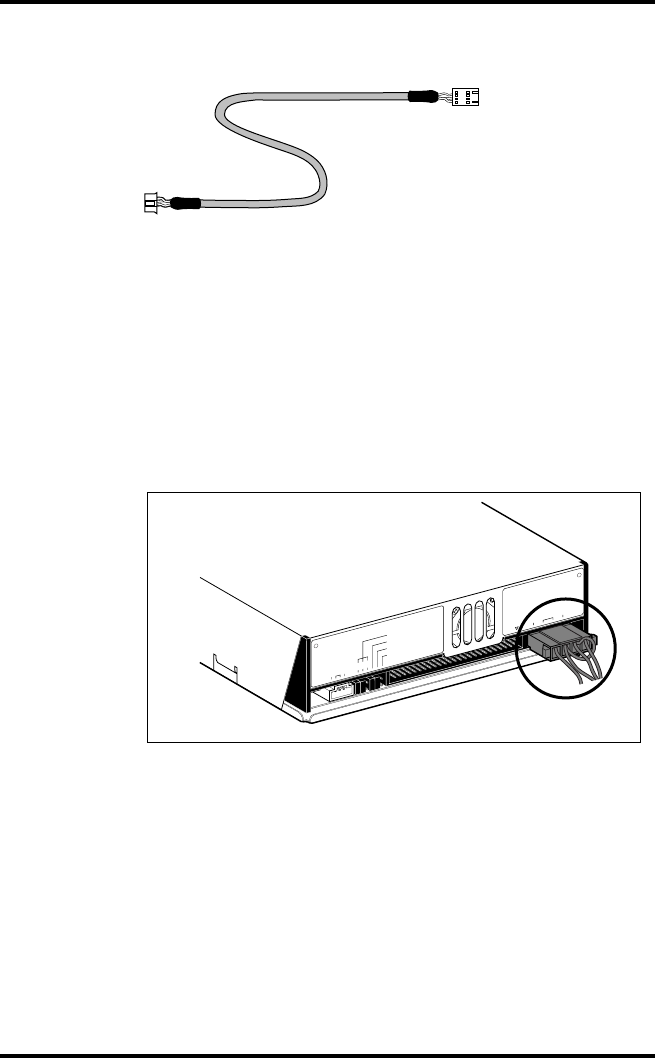
Chapter 2 - Installing the Yamaha CRW4416S Drive
11
AUDIO cable
9. Connect the power supply cable.
Connect the +12V and +5V 4-pin power cable to the power supply
interface located on the rear panel of the CRW4416S drive.
The shape of the connector makes it impossible to reverse the connec-
tions.
If you have difficulty when inserting the connector, try wiggling the
connector left and right while inserting it.
To the CRW4416S
4-pin connector (large)
To the Sound Card (Sound Blaster compatible)
4-pin connector (small)
R G L 1 2 4
ID SELECT
PARITY
TERMINATOR
BLOCK SIZE
AUDIO OUT
1 +5V G +12V
SCSI
INTERFACE
CONNECTOR DC INPUT
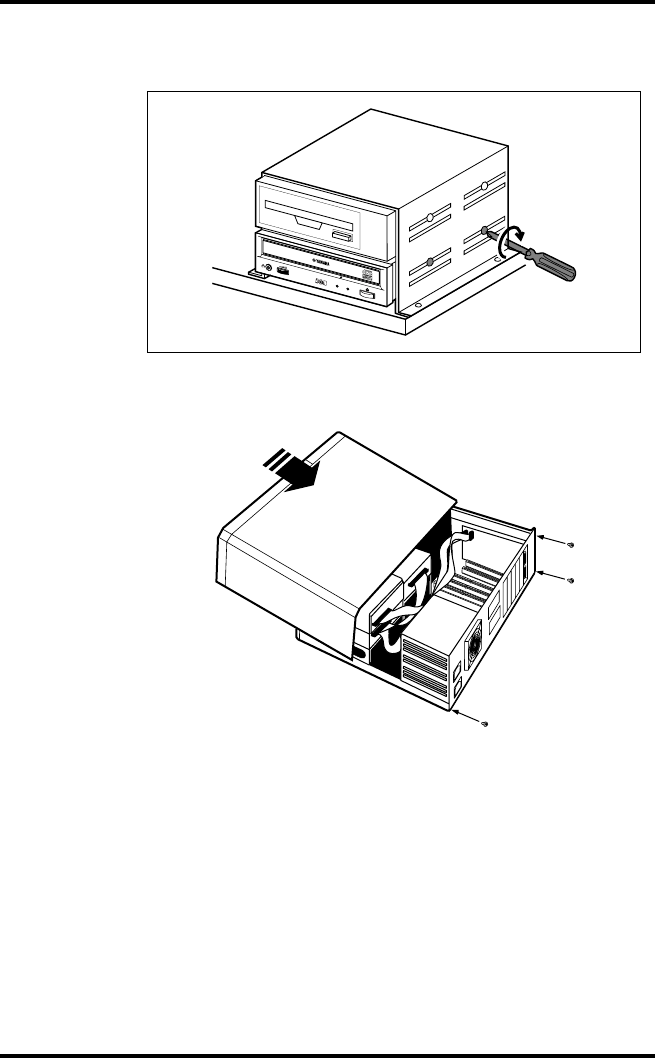
Chapter 2 - Installing the Yamaha CRW4416S Drive
12
10. Tighten the four fastening screws securely.
11. Attach the cover of your computer.
12. Connect the power cable to an AC outlet, and switch on
your computer.
Make sure that the LED located on the panel of the CRW4416S drive is lit.
13. Start up your operating system.
For the procedure, refer to the manual for your operation system.
14. Install the writing software.
For the installation procedure, refer to the manual for your writing soft-
ware.
ON
/
DISCREAD
/
WRITE
VOL
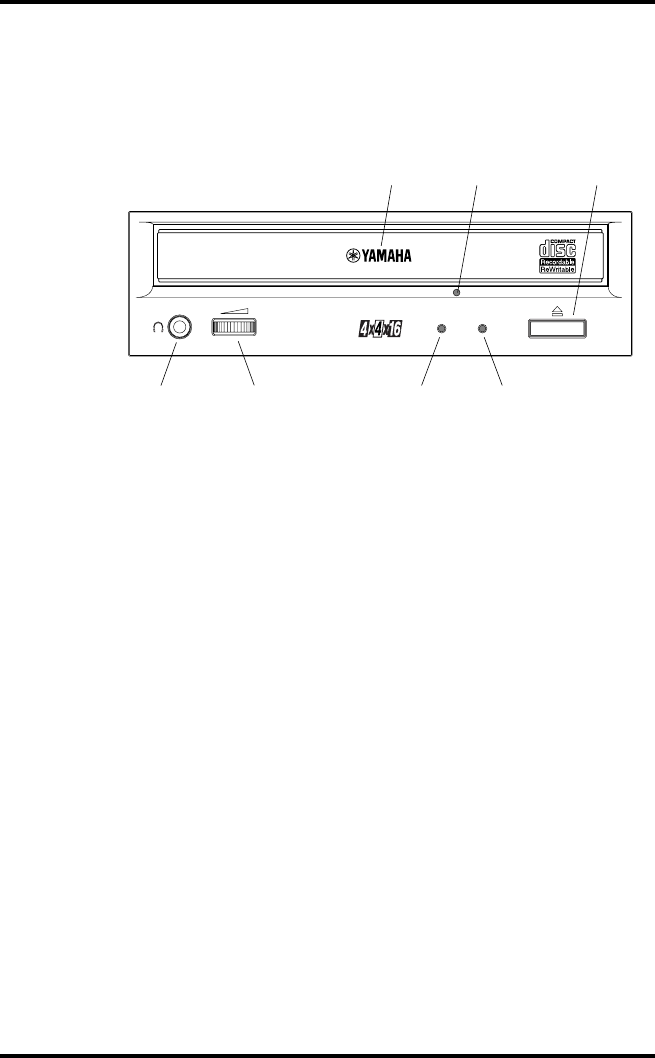
Chapter 3 - Operation
13
Chapter 3 - Operation
Front Panel
1Disc tray
The disc is inserted and ejected here. Pressing the eject button will
open the tray.
2Headphone jack
This stereo mini jack allows you to connect headphones and listen to
audio.
3Headphone volume control
This control adjusts the volume level of the headphone output. Rotating
the control clockwise will increase the volume level.
4ON/DISC LED
This indicator lights up in orange when the CRW4416S is powered on,
and lights up in green when the CRW4416S contains a disc.
5READ/WRITE LED
This indicator lights up in green when data is being read, and flashes
when data is being accessed. It also lights up in orange when data is
being recorded on a disc.
ON
/
DISC READ
/
WRITE
VOL
1 7 6
2 3 4 5
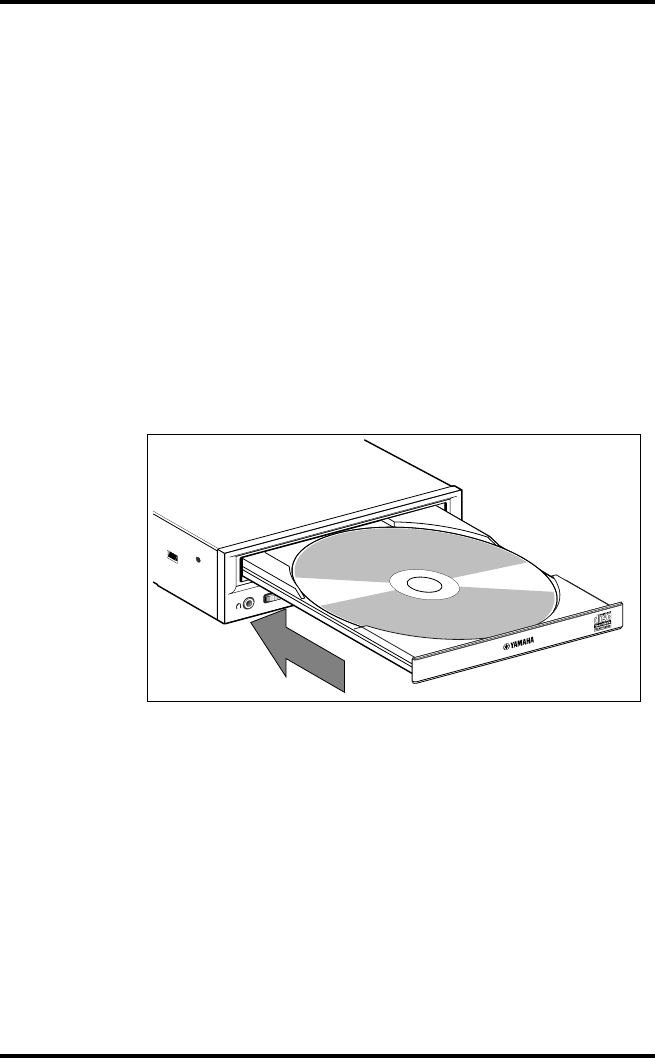
Chapter 3 - Operation
14
6Eject button
This button is used to open or close the tray.
7Manual Eject hole
This is used to manually eject a disc that cannot be ejected in the nor-
mal way. It is for emergency use only.
Loading a Disc
1. Press the eject button to open the tray.
2. Carefully place the disc, label-side up, on the disc tray.
3. Press the disc tray softly or press the eject button again to
close the disc tray.
ON
/
DISCREAD
/
WRITE
VOL
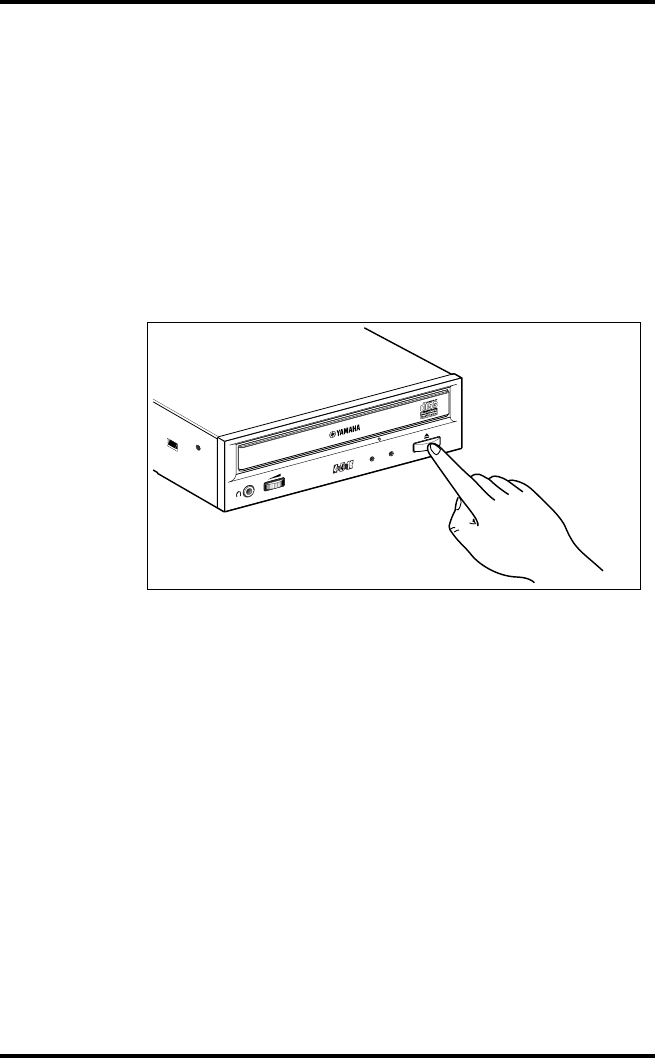
Chapter 3 - Operation
15
Ejecting the Disc
If the CRW4416S is powered on:
Press the eject button to eject the disc.
Note: You cannot eject the disc if the SCSI command prohibits the eject oper-
ation while the CRW4416S is reading data.
Caution: Be sure to remove the disc after it is completely ejected. (Trying to
remove the disc before it is completely ejected may cause the drive to
malfunction.)
If the CRW4416S is not powered on:
Pressing the eject button will not eject the disc.
ON
/
DISCREAD
/
WRITE
VOL
Press the eject button
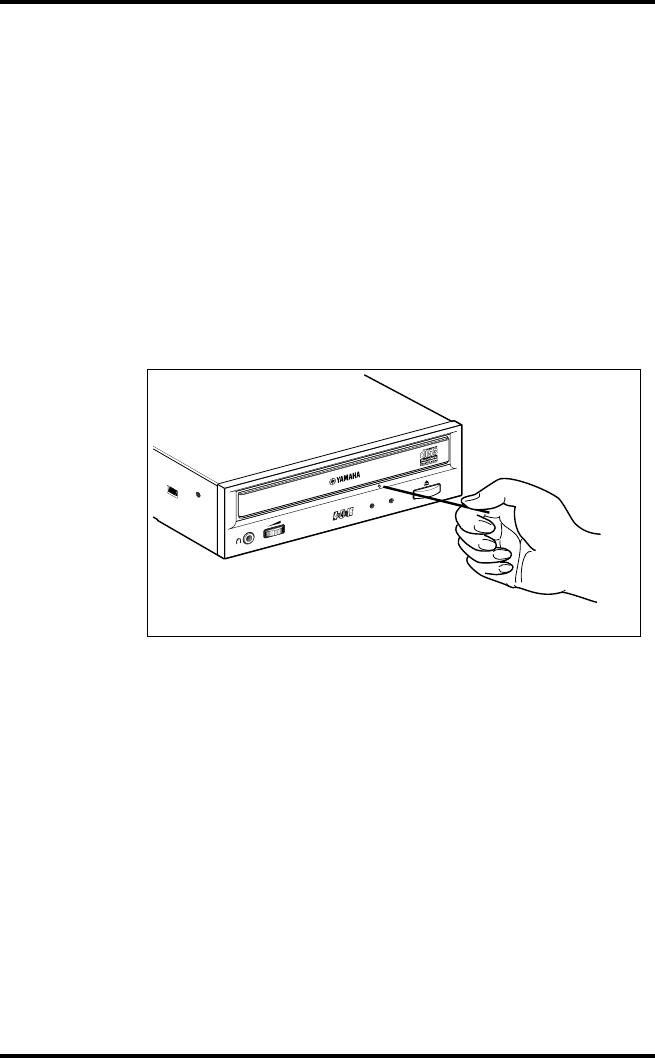
Chapter 3 - Operation
16
Manual Eject (emergency use)
Here we explain how to eject the disc when it cannot be ejected in the
normal way; for example, the power is shut off inadvertently or the
loading mechanism fails. This technique should be used only as a last
resort. Frequent use may lead to malfunction.
You’ll need a pin-like object of 2 mm or less in diameter to do this. A
straightened paper clip makes an ideal tool.
1. Insert the pin-like tool into the manual eject hole and push
gently.
The spring-loaded mechanism ejects the disc.
2. After manually ejecting a disc, you must turn off the power
supplied to the CRW4416S, then turn it on before continuing.
ON
/
DISCREAD
/
WRITE
VOL

Troubleshooting
17
Troubleshooting
If CRW4416S is not performing as expected, look up the symptoms in the following table,
and take the appropriate corrective action.
Note: In the case of CD-RW fixed packet writing, the recordable capacity will be approx-
imately 100 Mbytes less than the capacity indicated on the blank disc. This is due
to differences in the recording format.
Symptoms Corrective action
The power to the CRW4416S is off • Check the DC power cable connection.
The CRW4416S is not recognized by
the computer
• Check the SCSI cable connection.
• Make sure that SCSI ID numbers are assigned
exclusively.
• Make sure that the last device in the SCSI daisy
chain is terminated correctly.
The CRW4416S does not operate
correctly
• Install the SCSI driver software again.
The disc tray will not open • Make sure that the power to the drive is turned on.
The disc ejects • Make sure that the disc is seated in the tray cor-
rectly.
Incorrect operation • Make sure that the disc is seated in the tray cor-
rectly.
• Make sure that you are using the correct disc.
• Make sure that there is no dust, dirt, or conden-
sation on the disc or tray.

Appendix
18
Appendix
Specifications
Specifications are subject to change without prior notice.
Interface SCSI 2
Data Capacity 650MB (74 minutes disc)
550MB (63 minutes disc)
Record/Read Speed Writing (CD-RW): 2X speed, 4Xspeed
Writing (CD-R): Normal speed, 2X speed, 4Xspeed
Reading: Maximum 16X speed
Data Transfer Rate 150 - 2400KB/sec
Burst Transfer Rate Maximum 13.3 MB/sec
Buffer Size 2MB (666 sectors)
Access Speed 160 ms (Random access at reading)
Installation Horizontal
Disc Loading Tray
Audio Out
(normal speed)
Frequency Response
Output Level
20 - 20,000Hz (Line Out)
1 Vrms (Line Out)
Power Consumption 11W (read/write)
Power Supply 5V
±
5%, 12V
±
10%
Environment Temperature: +5
°
C - +40
°
C (read/write, when used in a
fan-cooled system)
Humidity: 5 - 85% (condensation must not occur)
Dimensions (WxHxD) 146 x 41.3 x 193.1 mm (excluding front panel)
Weight 950g
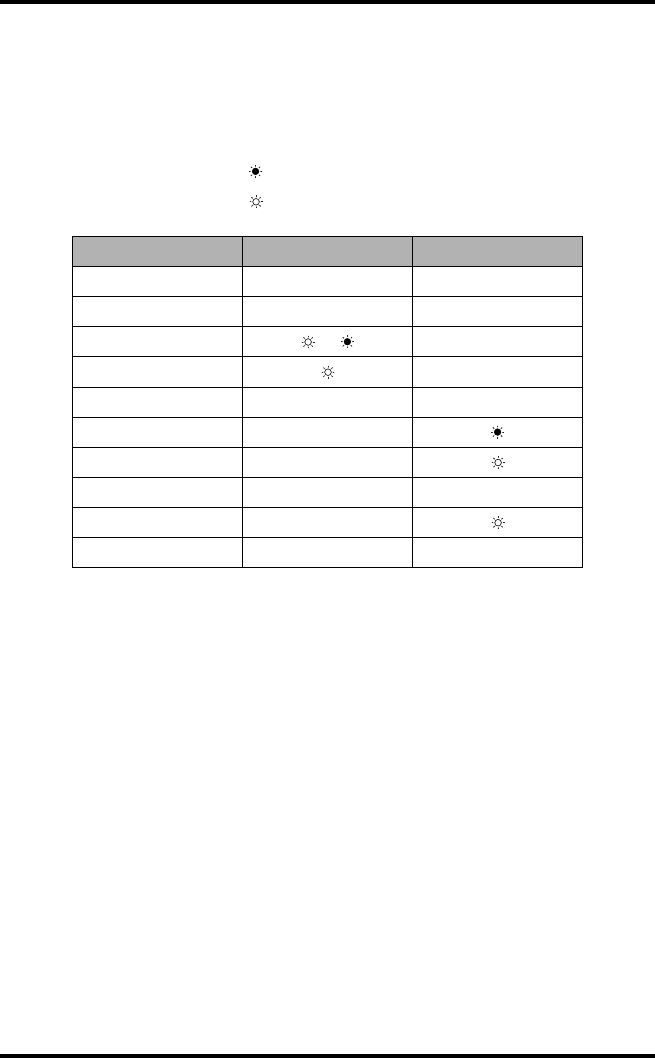
Appendix
19
Front Panel Indicator Key
● on: green flashing: green — off
❍ on: orange flashing: orange
Status ON/DISC READ/WRITE
Reset ❍ ➠ — ❍ ➠ —
Ready (no disc) ❍—
Inserting disc ➠ —
Ejecting disc —
Ready (disc inserted) ●—
Seeking ●
Preparing to write ●
Writing ●❍
Writing (test mode) ●
Playback ●●